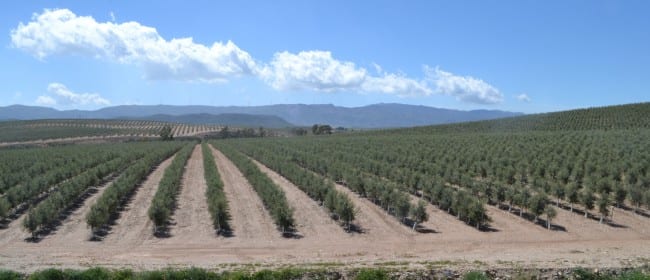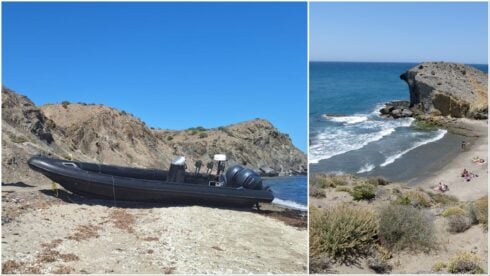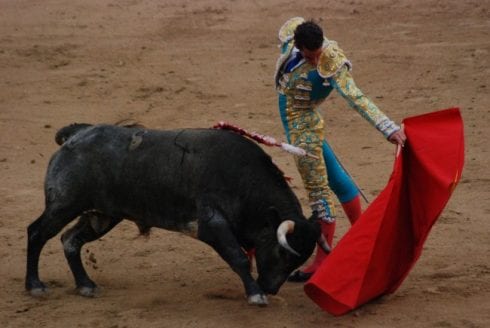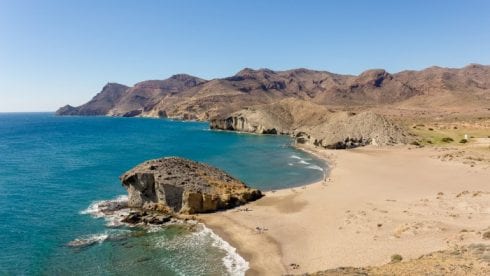 A SHRIVELLED fig tree, a stream flowing only with dust, scorched, grey earth and a litany of crumbling whitewashed houses sprouting For Sale signs.
A SHRIVELLED fig tree, a stream flowing only with dust, scorched, grey earth and a litany of crumbling whitewashed houses sprouting For Sale signs.
This is Gochar, a once proud, self-sufficient Almerian village, now almost completely deserted.
It is one of the most visible victims of the rampant over-exploitation of a precious aquifer dubbed the ‘last oasis in Europe’, which feeds this once-fertile region.

The Altos Agua aquifer lies beneath the semi-arid badlands of Sorbas.
Now 400 times more water is being taken from it than enters, an alarming situation that is being blamed on a surge in super-intensive olive production in the zone.
Planted at a density of up to 1,800 trees per hectare, each tree extracts around 10 litres of water a day.
With four million trees estimated to have been planted over 2,300 hectares within the last five years, the olive groves of Sorbas are guzzling an unprecedented 40 million litres a day.
“They’ve bled us dry,” said Manuel Ramos, one of the last permanent residents of Gochar.
Born in the village 63 years ago, he has seen his beloved home wither and die as the water ran out.

He and his wife Ana, 59, are now totally reliant on costly water piped into their village by Sorbas Council.
“People robbed us of our water supply by drilling big wells on their land to access the water to irrigate their crops.
“It’s the olive plantations that are the problem, I know.
“When I was growing up the valley was full of fruit trees. It was a pretty village.
“We grew pears and oranges along with many vegetables, like tomatoes, potatoes, cabbages, onions, and garlic, thanks to the stream and irrigation line that ran through the valley.
“One hundred families used to live in this village and many of us could work on the land.
“But now the lack of water has forced them to move and find work elsewhere.
“We feel very let down by the authorities. There has been no fight among the people. As we were just a small village it made it hard to make a stand.”

On the other side of the village Juan Perez Ramos, also a native of this dusty soil, sweeps out the house he says he can only now use as a holiday home.
“It’s a disaster,” says Juan, who now lives in Barcelona.
“The problem really worsened 10 years ago.
“It’s just not viable for most people to stay. I miss my neighbours terribly but what can you do?”
He pointed to a dried up irrigation line which was once buzzing with villagers washing clothes, and an abandoned school, which closed when the population began to free fall.
Ivan Rodriguez, 20, and his two friends kick the dirt listlessly.
“We’re visiting my parents who still live here,” says Ivan.
“I’ve had to move to Almeria as I can’t work here. It’s a shame but what can we do?”

The fate of Gochar is a startling reminder of what could happen to other nearby towns and villages reliant on the aquifer.
Home to 10,000 people, they include the town of Sorbas and a host of pueblos including Lucainena, Uleila, Bédar, Los Canales, Los Perales, La Herreria and Los Molinos del Rio de Aguas.
In some places, like Sorbas, householders have to queue up daily to fill containers with drinking water from the tanker that now supplies them.
Clinging to a valley above a spring fed by the aquifer, Los Molinos has become a crucial site of study for biology and geology professor Jose Maria Calaforra of the University of Almeria.
He has studied the disappearance of water from the aquifer and is unequivocal that super-intensive olive farming is the main catalyst behind the drought.
“The aquifer currently is 100 square hectometres in size,” says Jose.
Jose.
“We have calculated that it is now being over exploited by 400%. This makes it the most over-exploited aquifer in Andalucia.
“And I strongly believe that super intensive olive cultivation is responsible for around 80% this overexploitation.
“You only have to look at aerial pictures or Google Earth to see that the super-intensive groves lie over the area of the aquifer.
“What’s more, the rate at which the level has rapidly dropped in the last five years correlates with the boom in the creation of super-intensive olive groves here.
“From studies taken at Los Molinos, we know that the flow of water was around 40-75 litres per second in the 1980s and 1990s.
“But in our 2014 study, this had dropped to only 3.2 litres per second.
“In 10 years, with an estimated reserve of 100 hectometres in the aquifer, and an overexploitation of 10 hectometres a year, the aquifer will be dry.
Jose first denounced the super-intensive groves to Andalucia’s

Junta and Almeria’s council on Canal Sur news in 2014, via the campaigning group Plataforma en Defensa del Agua en Almería ‘Acuíferos Vivos’.
Other groups including GEM (Group Ecologists Mediterranean) and Ecologistas en Accion have denounced both the Junta and Medio Ambiente.
The New Environmentalists conservation group has also spoken out, while Podemos recently pressed the Junta on its plans to tackle the issue.
Some of the super-intensive olive groves stretch to the horizon.
Tightly packed and only a couple of metres in height, the ground they grow from is turning to desert.
Plastic irrigation pipes run down each tree line, releasing the nutrients the trees need to start producing in as little as three years – several years less than those farmed by traditional methods.
With no shade to protect the pipes from the heat of the day, the loss of water to evaporation is high.
A ride through the groves reveals a 50×200 metre elevated reservoir that rises far above the trees with pipes running into the ground.

According to Ian Holborn of New Environmentalists who carried out a study in 2016, 41 of these large water reservoirs now exist in the aquifer-dependent area.
All are associated with agricultural use.
Large boreholes are found in other parts of the plantation, all of which David Dene, an environmental campaigner from Los Molinos village, believes connect to the aquifer.
“These super intensive plantations are creating an ecological desert,” he says with feeling.
“They are devastating the earth as well as rapidly depleting the aquifer. It’s crazy to allow so many in a semi-arid zone.
“These super intensive plantations are fully mechanised. They destroy work opportunities for local people and rob small farmers and local communities of water. They are a spiral of disaster and destruction.”
Despite attempts by Olive Press reporters to contact super intensive producers in the area, none could be reached for a comment.

The Junta has stated that all cultivators must now apply for a license to create a borehole, and is beginning to crack down on those which are illegal.
According to a recent report, around 14 have been sanctioned for illegitimately extracting water.
The Junta has also suggested shipping in desalinated water from Carboneras, a three-pronged plan it believes could restore water to a safe level by 2027.
But for Jose, these measures are inadequate.
“The issue here is a lack of real planning,” he said.
“The desalination plan will be impossible in reality as it’s far too cost prohibitive. The water will have to be transported a long distance and there is the expense of the process estimated at €60m.
“The cost per ton could well be between €1 to €2 which would leave olive plantations bankrupt.
“The only thing we should do is stop licensing them but the Junta has started too late.
“The overexploitation must be stopped by introducing new laws encouraging cultivators to move from super-intensive to traditional farming.
“This is where trees are at least five metres apart, take longer to reach maturity and are left to grow naturally, not ripped out of the ground and replaced after 15 years.”
Back in Los Molinos, David Dene voices fears for the future of the

village that has been his home since the 1990s, a progressive community pioneering half a dozen eco-living projects.
David set up the Ecocide el Rio de Aguas campaign group and Facebook page after noticing the rapid drying up of the river in 2013.
“It’s an ecocide,” he says passionately.“We’re totally dependent on the aquifer for survival.
“This village has been here since Neolithic times but now it’s getting harder and harder to get our water due to the decreasing flow.
“If nothing changes, we have no more than five or six years left here.
“This aquifer is the future for the next generation. We need to stand up for them and nature.”
David has been busy taking on the bureaucratic Goliaths in his battle to save his village, and all the way to the European Union.
He has denounced the EU for failure to enforce directives under Nature 2000, he has fielded a question in the European Parliament and filed a petition for EU help.
He has also enrolled a UN Special Rapporteur (Dr John Knox) on the Human Right to a Safe and Sustainable Environment, and hopes he will urge the Spanish government and the Junta to act on the issue.
“This overexploitation is trashing our human rights, which is why the U N is now involved,” he says.

The depleting aquifer is also wreaking havoc on the biodiversity of the area.
‘There is a unique ecosystem not found elsewhere in world,’ states Ian Holborn in his 2016 report.
‘The associated flora and fauna of the habitats that have lost flowing water will die.’
Among the species he lists at risk are the Mediterranean turtle, Bonelli’s eagle, the Chamaeleo chamaeleon, the spur-thighed tortoise, the natrix natrix grass snake.
and the Mediterranean horseshoe bat.
He also points the finger at the ‘intensive plantations that are rapidly expanding around the park and are a major threat due to the ‘high levels of water required for irrigation.’
He blames the boom of the plantations on the EU’s Common Agricultural Policy in Andalucía, which granted subsidies to encourage agricultural production and aid development of the rural economy.
Tragically, the ransacking of the aquifer has echoes around Spain.
One hundred kilometres north In Los Velez, giant lettuce farms spanning 500 kilometres have been blamed for sapping dry an aquifer used by small scale producers for thousands of years.
Intensively irrigated olive groves near to the Guadalquivir river in Cordoba and Sevilla have also been condemned for overexploitation of water.
Meanwhile, WWF España has demanded the closure of illegal boreholes and irrigation systems in the wetlands of Donana National Park wetlands, which is also under threat of being drained dry.
La Mancha is another hard hit region, with the Ojos del Guadiana and las Tablas de Daimiel aquifers among several at risk in substantial part to thoughtless agricultural practices.

The European Commission has stated that it is aware of the overexploitation of different sources in the country and considers it a ‘systemic problem.’
Back in Los Molinos, David sits down with other villagers to discuss the next step in the campaign.
A recent festival brought hundreds of people to the village, where the seriousness of the situation was unveiled to them over the beat of live music.
“A problem we continue to have is getting enough people to speak out,” said David.
“A lot of local people have links in some way to the related companies of the growers.
“This is why we need more people to help us keep pushing this issue by joining our campaign and coming to our events.
“This, and demanding law from the Junta to prohibit super-intensive olive production in Almeria province are the only ways we can make the politicians who have the power to stop them sit up and listen.”
Click here to read more News from The Olive Press.









Can someone publish list of olive oil from sustainable plantation? Or, if not, olive oil brands from the worst water use offenders? We would like to support the water sustainable efforts.
Can someone publish list of olive oil from sustainable plantation? We would like to support the water sustainable efforts.